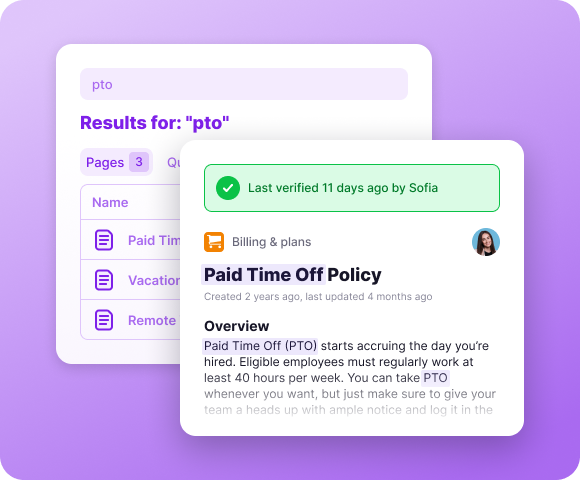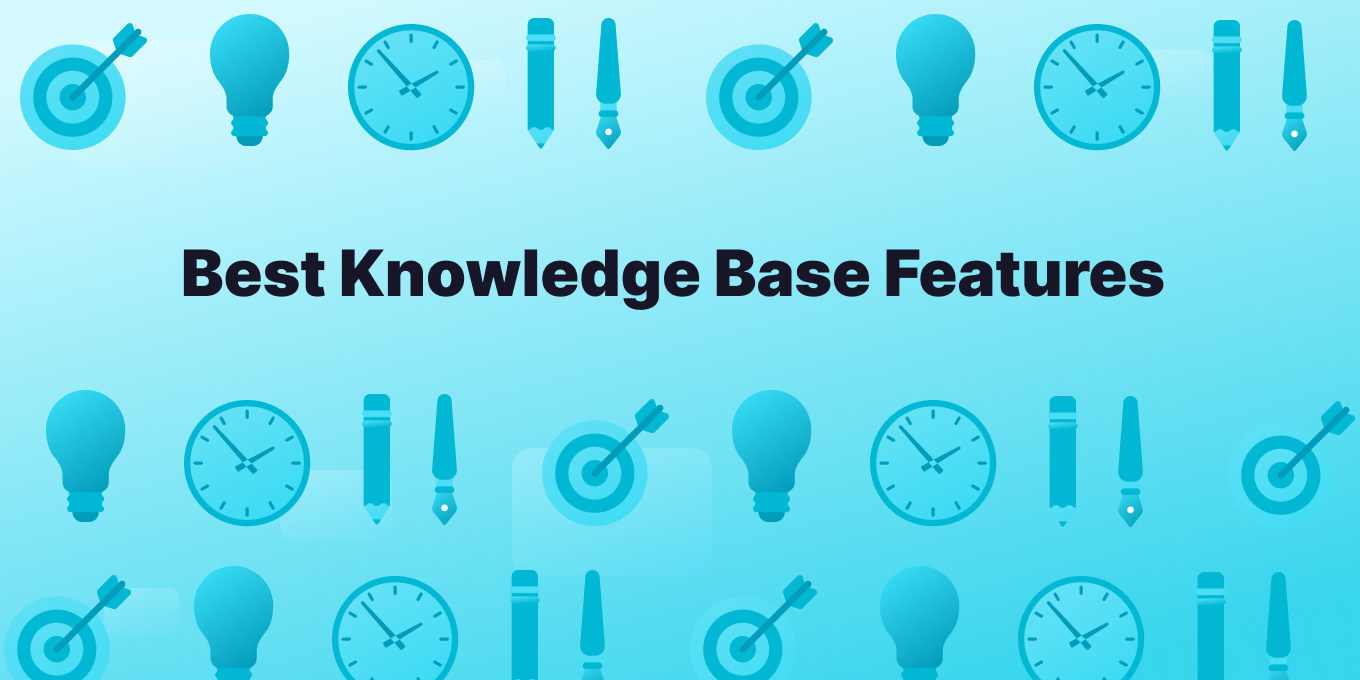The most business-critical features for a knowledge base?
Those that enhance the user experience, help team members efficiently find information, and facilitate effective knowledge sharing.
These features are essential for businesses looking to streamline their operations, improve customer support, and empower their employees with valuable insights.
The following knowledge base features are particularly crucial:
1. User-Friendly Interface & Navigation
An intuitive and easy-to-navigate interface is vital in your knowledge base software to encourage user engagement and make it effortless for users to find the information they need.
Navigation should be no-nonsense, so users can find the information they need.
Clear and well-organized menus, breadcrumbs, and logical category structures point your employees to relevant articles without confusion.
Because users access information from various devices, a knowledge base must have a responsive design that adapts seamlessly to different screen sizes, providing an optimal user experience across desktops, tablets, and smartphones.
- More Questions about Knowledge Bases? Check out this FAQ
2. Advanced Search Functionality
The search function serves as the backbone of a knowledge base.
Implementing advanced search capabilities, such as auto-suggestions, filters, and Boolean operators, improves search accuracy, helping users quickly locate the right content.
3. Categorization and Tagging
Categories, hierarchical tagging, and metadata tagging make for a better knowledge base.
Organizing knowledge base articles with hierarchical categories helps users drill down to specific topics. Metadata tagging ensures content is well-structured and easily discoverable. And a good taxonomy enhances the knowledge base’s organization, grouping related articles together and enabling users to explore content with greater precision.
4. Access Control and Permissions
Role-based access control guarantees that sensitive information is only accessible to authorized personnel, maintaining data security and confidentiality. Creating user groups, private categories, and permissions guarantees that they can access content relevant to their roles, maintaining data security and confidentiality.
5. Version Control
Tracking changes and providing a detailed revision history helps ensure content accuracy and enables effective content management.
In case of errors or unintended changes, the ability to revert to previous versions (document rollback) of an article ensures content accuracy and consistency.
Being able to see what changes were made, who made them, and when they were made can be crucial for maintaining a reliable and transparent knowledge base, and is a big part of version control.
6. Article Templates, Formatting, and Markdown
Re-usable templates and consistent formatting ensure a professional appearance throughout your company’s internal knowledge base.
Using predefined templates with consistent formatting and layout ensures that all articles have a standardized appearance, making them more accessible and visually appealing.
Offering both markdown and rich text editors accommodates users with different skill levels, enabling them to create or edit content as per their preferences.
7. Analytics and Insights
Data-driven insights into user behavior, popular searches, and content performance assist in identifying areas for improvement and gaps in your knowledge base content.
Collecting data on how your team uses the knowledge base helps identify popular articles, user preferences, and areas that need improvement.
Popular Searches: Understanding the most commonly searched terms enables content creators to focus on topics of high interest and relevance.
Content Performance Metrics: Analyzing content performance metrics, such as views, ratings, and user feedback, aids in assessing the effectiveness and impact of the knowledge base articles.
At Tettra, you’ll receive daily & monthly reports that shows how well your team is using the internal knowledge base:
- The number of pages created in the previous month
- The number of pages viewed in the previous month
- The top pages and their view count
- The most active users
- The number of pages each user created
- The number of pages each user viewed
At the end of each page, you’ll also see how many times it’s been viewed and when the page was created.
8. External Content Linking
The ability to link to credible external resources and references expands the knowledge base’s scope and enhances its credibility as a documentation tool.
Visual aids, such as image galleries, diagrams, and infographics, enhance the understanding of textual content and make the knowledge base more engaging.
Link out to any site you want with Tettra: This could include a Google Doc, Microsoft Office, slide decks, or any other productivity tool with an external link like ClickUp, Notion, or Dropbox.
Providing references and citations for articles boosts the trustworthiness of the knowledge base and supports the processes with real-life examples and ideas.
9. AI-Powered Answers
AI-powered chatbots answer users’ queries promptly and efficiently. When considering a knowledge base, this is important because when your team is searching for an answer they won’t use the exact words that may be in your documents or processes.
Kai (Tettra’s AI bot) can interpret the team’s question, provide a summary of the answer, and then link directly to the page references.
The adaptive learning algorithms of Kai in Tettra improves its abilities to understand and provide better answers every time. Personalizing content recommendations based on user behavior improves team engagement with the knowledge base.
It can also automatically generate FAQs based on current responses and anticipates what other questions a user may have.
10. Third-Party Integrations
Look for a knowledge base that can connect to outside tools. These will enhance its overall utility and productivity. Many teams who use a knowledge base like Tettra, like the fact taht you can search for pages right inside of Slack, while also connecting your Google Drive, Zapier, Github, and others.
Looking for a knowledge base? Try Tettra.
The best internal knowledge base software is Tettra because of its search functionality, Slack integration, and intuitive UI.
Tettra has strong search and content management functionalities; it has good access and permission controls; it integrates with popular enterprise apps like Slack and Google Docs; all wrapped up in an easy-to-use interface that is intuitive even for non-technical users.

It possesses all of the important features that you need in a knowledge base solution. Plus your whole team can use it. It’s not built only for engineers, which is especially helpful if you are a small business.
Tettra offers a full suite of tools for sharing knowledge. With Tettra, you’ll get:
- Q&A workflow to capture questions
- AI-powered knowledge base software to answer questions & create FAQs
- Knowledge management features to keep content up to date.
- Integrations with Slack, Google Docs, Github and Zapier to help your team answer and capture knowledge quickly


